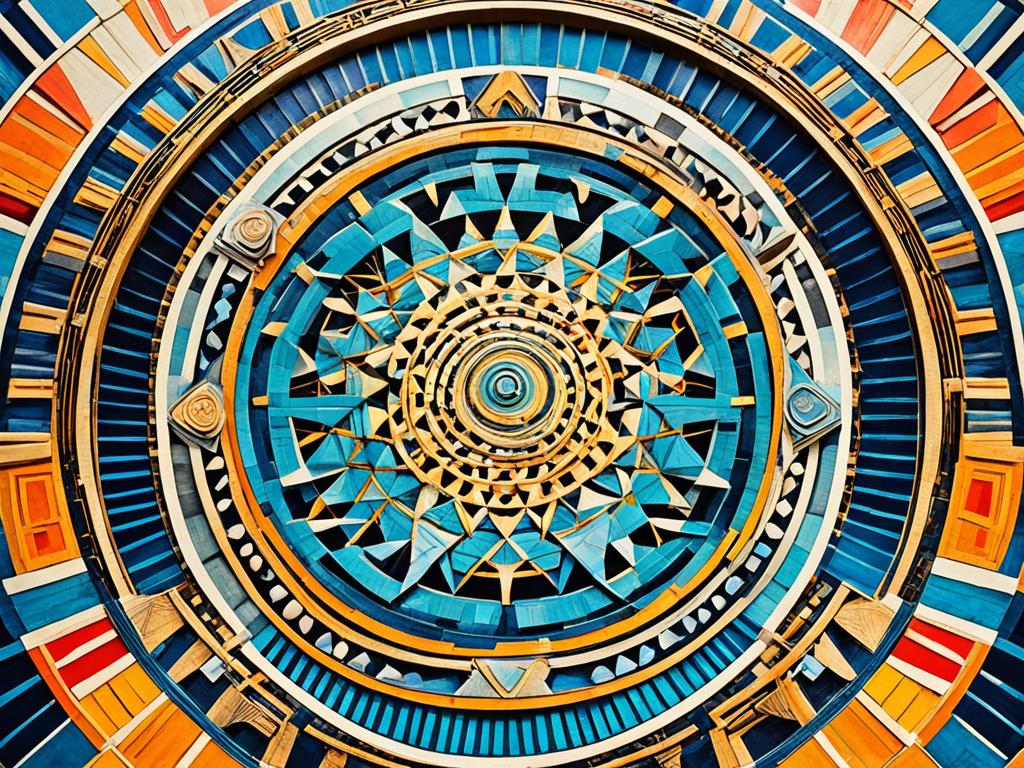Welcome to an exploration of the fascinating connections between ancient civilizations and modern art. Throughout history, the art world has been deeply influenced by the rich cultural heritage of ancient societies. From the awe-inspiring pyramids of Egypt to the monumental architecture of Rome, the traces of these civilizations can still be felt in the artistic expressions of our contemporary world.
As we delve into the topic of the influence of ancient civilizations on modern art, we will uncover the remarkable ways in which artists have drawn inspiration from the past to shape our present. Join us on this journey as we explore the enduring legacy of ancient cultures and their impact on artistic expression.
But first, let us take a moment to reflect on the profound connection between art and history. By immersing ourselves in the stories and artistic achievements of ancient civilizations, we gain a deeper understanding of our shared human experience and the universal language of creativity.
Key Takeaways:
- Ancient civilizations have had a significant impact on modern art, shaping artistic expression throughout history.
- Artists often draw inspiration from the artistic achievements of ancient civilizations such as Egypt and Rome.
- The Renaissance marked a resurgence of interest in ancient civilizations and the incorporation of ancient techniques into contemporary practice.
- Various modern art movements, including Cubism and Surrealism, have been influenced by ancient civilizations.
- Ancient techniques and artistic processes continue to be utilized by contemporary artists, bridging the gap between the past and the present.
From Ancient Egypt to Rome: Inspiring Art Across Millennia
The artistic heritage of ancient civilizations such as Egypt and Rome has left an indelible mark on the world of modern art. Their achievements in various artistic disciplines continue to inspire and influence artists today, bridging the gap between ancient and contemporary artistic expression.
Ancient Egypt, with its rich history and iconic landmarks, has long captivated the imaginations of artists. From the mesmerizing beauty of the pyramids to the intricate hieroglyphics adorning ancient tombs, the art of Egypt reflects a deep reverence for spirituality and the afterlife. Artists often draw inspiration from the enigmatic symbolism and striking aesthetics of ancient Egyptian art, incorporating elements such as stylized forms, vibrant colors, and intricate patterns into their own work.
“Ancient Egyptian art is a testament to the enduring power of visual storytelling. The way they depicted figures, using a combination of profile and frontal views, creates a sense of depth and narrative within the artwork, captivating audiences even thousands of years later.”
Rome, one of the greatest empires in history, also played a significant role in shaping the artistic landscape. The Romans were known for their grand architectural achievements, such as the Colosseum and the Pantheon, as well as their mastery of sculpture and mosaics. The art of Rome demonstrates a meticulous attention to detail, a celebration of human form, and a focus on capturing realistic expressions and emotions.
Modern artists frequently reference classical Roman art, paying homage to the technical skill and compositional harmony of ancient Roman works. They may incorporate Roman motifs, such as arches and columns, into their pieces to evoke a sense of grandeur and timelessness. Additionally, the enduring influence of Roman mythology and legends continues to inspire artists to explore themes of heroism, conflict, and moral dilemmas in their creations.
Whether through reinterpretation, homage, or direct emulation, ancient Egypt and Rome have provided a wellspring of inspiration for contemporary artists. Their artistic achievements have transcended time and continue to infuse modern art with a sense of cultural richness and timeless beauty.
The Renaissance: Rebirth of Classical Ideals
The Renaissance was a transformative period in the history of art, characterized by a renewed interest in classical ideals and ancient techniques. This cultural movement, which originated in Italy in the 14th century and later spread throughout Europe, marked a significant departure from the artistic styles of the Middle Ages.
During the Renaissance, artists sought to revive the aesthetic principles and intellectual pursuits of classical antiquity that had been largely forgotten during the medieval era. The renaissance, meaning “rebirth” in French, symbolizes the revival of classical knowledge and the exploration of human potential.
One of the key features of the Renaissance was the emphasis on realism and the accurate representation of the human form. Artists such as Leonardo da Vinci and Michelangelo drew inspiration from ancient Greek and Roman sculptures, studying the proportions and anatomical details of the human body to create lifelike figures in their paintings and sculptures.
“The artist is a receptacle for emotions that come from all over the place: from the sky, from the earth, from a scrap of paper, from a passing shape, from a spider’s web.” – Pablo Picasso
A notable aspect of the Renaissance was the incorporation of ancient techniques in contemporary artistic practice. Artists turned to ancient treatises on painting and sculpture, studying the methods and materials used by ancient masters. They experimented with new techniques in perspective, proportion, and shading, aiming to achieve a level of naturalism and depth that mirrored the achievements of classical art.
One of the defining works of the Renaissance is Leonardo da Vinci’s “The Last Supper,” a masterpiece that showcases the artist’s mastery of perspective and his ability to capture human emotion. This iconic painting reflects the revival of classical ideals of harmony, balance, and proportion.
The Renaissance not only revolutionized the way art was created but also transformed society’s perception of the artist. Artists were no longer seen as mere artisans but as intellectuals and visionaries, capable of elevating humanity through their creative expressions.
The renaissance exalted the individual, encouraging artists to explore their own perspectives and unique artistic voices. This emphasis on individuality and self-expression was a departure from the collective mindset of the Middle Ages, aligning with the humanist ideals of the time.
Renaissance Art Characteristics:
- Realism and accurate representation of the human form
- Revival of classical ideals of harmony, balance, and proportion
- Incorporation of ancient techniques in contemporary practice
- Exploration of perspective and depth
- emphasis on the individual artist as an intellectual and visionary
| Key Figures | Key Works |
|---|---|
| Leonardo da Vinci | Mona Lisa The Last Supper |
| Michelangelo | David The Creation of Adam |
| Raphael | The School of Athens Madonna and Child |
Modern Art Movements Inspired by Antiquity
Throughout history, ancient civilizations have served as a wellspring of inspiration for artists, shaping the trajectory of artistic movements. From the bold geometric forms of Cubism to the surreal dreamscapes of Surrealism, and the expressive freedom of Abstract Expressionism, modern art has been deeply influenced by the rich tapestry of ancient cultures.
“Art is the eternal bond that connects us to our ancestors, allowing us to explore their world and infuse it with our own vision.”
Incorporating Ancient Aesthetics: Cubism
One prime example of a modern art movement deeply influenced by antiquity is Cubism. Developed by Pablo Picasso and Georges Braque in the early 20th century, Cubism sought to break free from the confines of traditional representation by fragmenting subjects and representing them through multiple perspectives. The Cubists drew inspiration from ancient art forms such as African masks and Iberian sculpture, infusing their work with a sense of primal energy and non-conformity.
Unlocking the Subconscious: Surrealism
The Surrealists, led by André Breton, sought to explore the subconscious mind and challenge rationality. Ancient civilizations, with their mythologies and esoteric symbols, provided a fertile ground for the Surrealists’ exploration. Artists like Salvador Dalí and Max Ernst incorporated motifs from ancient art, creating enigmatic compositions that transcended reality and tapped into the collective unconscious.
Expression through Gesture: Abstract Expressionism
Abstract Expressionism emerged in the mid-20th century as a response to the tumultuous nature of the world. Artists such as Jackson Pollock and Willem de Kooning looked to ancient civilizations for inspiration in their quest to harness raw emotion and express it through their art. By drawing upon the primal energy of ancient cultures, these artists created works that embodied both chaos and harmony, allowing viewers to connect with their own emotions on a profound level.
The Enduring Implications
The influence of ancient civilizations on modern art movements goes beyond mere stylistic borrowing. It represents a profound acknowledgement of the continuity of human experience and the enduring relevance of the ancient world. These art movements not only pay homage to the past but also serve as a bridge between the ancient and the contemporary, reminding us of our shared human history and the timeless power of artistic expression.
Through the lens of modern art, we can witness the interplay between past and present, revealing the universal themes that have captivated creative minds throughout the ages. The influence of ancient civilizations will continue to shape and inspire artists for generations to come, ensuring that the legacy of the past lives on in the vibrant tapestry of modern artistic expression.
| Modern Art Movement | Inspired by |
|---|---|
| Cubism | Ancient African masks and Iberian sculpture |
| Surrealism | Ancient mythologies and esoteric symbols |
| Abstract Expressionism | Ancient cultures’ primal energy and expression |
Ancient Techniques in Contemporary Practice
Even in the fast-paced and ever-evolving world of modern art, ancient techniques and artistic processes continue to find valuable applications. Contemporary artists draw inspiration from the rich legacy left behind by ancient civilizations, incorporating their techniques, materials, and methods into their work. This fusion of the old and new exemplifies the ongoing influence that ancient civilizations have on modern art.
One such ancient technique that has found resonance in contemporary practice is encaustic painting. This technique, which involves using heated beeswax to bind pigments, was first utilized by the ancient Egyptians and Greeks. Artists today embrace encaustic painting for its versatility, as well as its ability to create luminous and textured surfaces that add depth and complexity to their artwork.
Another ancient technique that continues to captivate modern artists is mosaic art. Originating thousands of years ago in ancient Mesopotamia, mosaic art involves assembling small pieces of colorful materials, such as glass, ceramic, or stone, to create intricate designs and patterns. Contemporary artists, like Sonia King and Isaiah Zagar, have mastered the art of mosaic, pushing its boundaries and integrating it into innovative and visually striking installations.
“Working with ancient techniques allows me to pay homage to the craftsmanship and ingenuity of past civilizations while infusing my art with a sense of history and connection,” says artist Sonia King.
Furthermore, the practice of metal casting, which has been traced back to ancient Mesopotamia, continues to be embraced by contemporary sculptors. Artists like Wendell Castle and Louise Bourgeois create intricate and expressive sculptures by molding molten metal into desired forms. Metal casting allows artists to explore the juxtaposition of strength and fragility, just as ancient craftsmen did centuries ago.
Ancient Techniques in Contemporary Art – Examples
To illustrate the seamless integration of ancient techniques into contemporary practice, let’s explore a few notable examples:
| Artist | Technique | Artwork |
|---|---|---|
| Sheila Hicks | Textile Art | |
| Shozo Michikawa | Pottery | |
| Julie Mehretu | Drawing and Printmaking |
These artists exemplify the seamless incorporation of ancient techniques into their contemporary practice, pushing the boundaries of artistic expression while paying homage to the ancient civilizations that laid the foundation.
The enduring influence of ancient civilizations on modern art is evident in the continued utilization of ancient techniques and the exploration of historical processes in contemporary practice. Artists worldwide continue to draw inspiration from the ingenuity and artistic achievements of past civilizations, bridging the gap between the ancient and the modern, and creating artwork that resonates with both past and present.
Connecting the Past and Present: Bridging Millennia through Artistic Expression
Ancient civilizations have left an indelible mark on the world of art, influencing and inspiring artists across different time periods. The enduring influence of ancient cultures on modern art serves as a bridge connecting the past and present, allowing us to appreciate the rich legacy that has been passed down through the ages.
Artistic ideas and techniques that originated in ancient civilizations continue to resonate with contemporary artists. The influence of ancient civilizations on modern art can be seen in the use of symbolism, composition, and subject matter. Artists draw inspiration from the ancient world, incorporating its themes and motifs into their work to create a connection between ancient and modern cultures.
One example of this connection can be seen in the enduring fascination with Egyptian art. Ancient Egyptian motifs, such as hieroglyphics, gods and goddesses, and intricate patterns, have found their way into modern art. The works of renowned artist Salvador Dali often feature Egyptian symbolism, blurring the boundaries between past and present.
“Art has no boundaries of time or space. It is a language that allows us to communicate across centuries, linking us to the ancient civilizations that came before us.” – Salvador Dali
The ancient Greeks and Romans also continue to inspire modern art. The classical ideals of beauty, balance, and proportion are still highly regarded today. Many contemporary sculptors and painters draw on these ancient techniques and adapt them to create artworks that resonate with a modern audience.
The art of storytelling is another aspect where ancient civilizations have influenced modern artists. The myths, legends, and epic narratives of ancient cultures have provided a rich source of inspiration for contemporary artists. Their works explore universal themes, connecting us to the timeless human experiences depicted in ancient tales.
The influence of ancient civilizations on modern art also extends to the preservation and revival of ancient techniques. Artists today often incorporate traditional materials and processes into their work, allowing them to connect directly with the craftsmanship of ancient artists. By embracing these ancient techniques, contemporary artists ensure that the legacy of ancient civilizations continues to flourish.
Timeless Inspiration: Ancient Civilizations in Contemporary Art
Contemporary artists continue to find inspiration in the influence of ancient civilizations on modern art. They pay homage to the past and create artworks that bridge the gap between different time periods. These artists demonstrate the enduring power of ancient cultures to captivate and inspire the artistic imagination across millennia.
Conclusion
Throughout history, the influence of ancient civilizations on modern art has been undeniable. From the grandeur of ancient Egypt to the classical ideals of Rome, the art world has continually drawn inspiration from the rich legacy left by these ancient cultures.
From the Renaissance to modern art movements, artists have found creative ways to incorporate elements of antiquity into their work. The enduring influence of ancient civilizations can be seen in the use of ancient techniques, materials, and themes by contemporary artists.
By acknowledging and appreciating the connection between the past and the present, we gain a deeper understanding of the universality and timelessness of art. The influence of ancient civilizations on modern art serves as a reminder of our shared cultural heritage and the enduring power of artistic expression.







